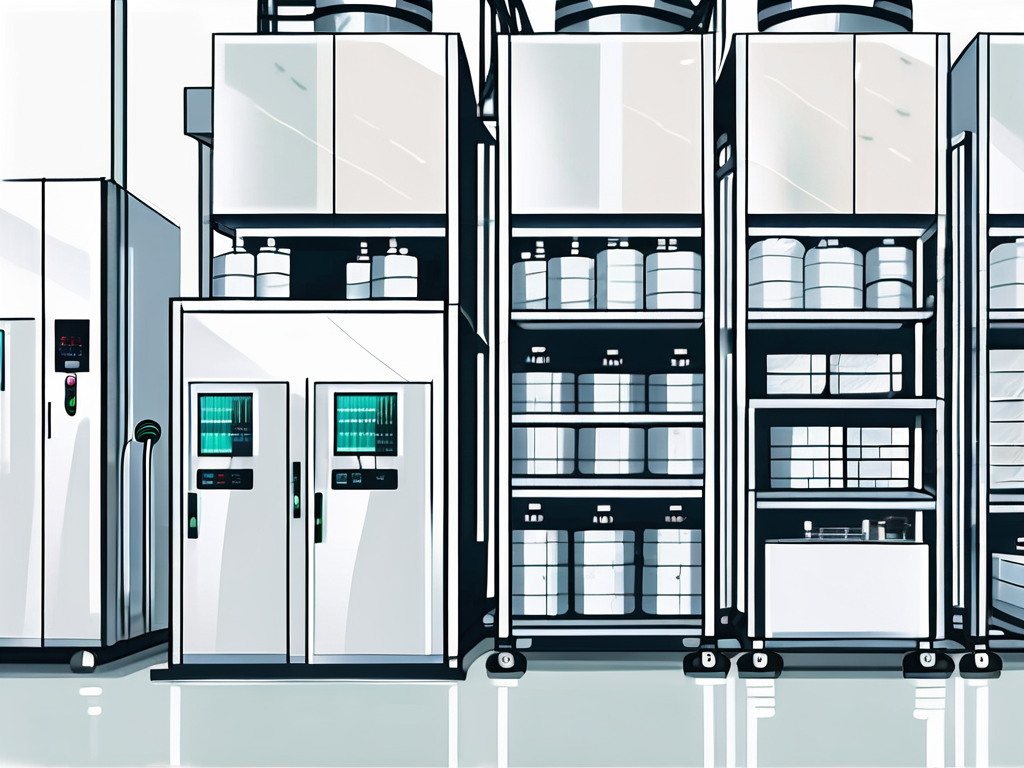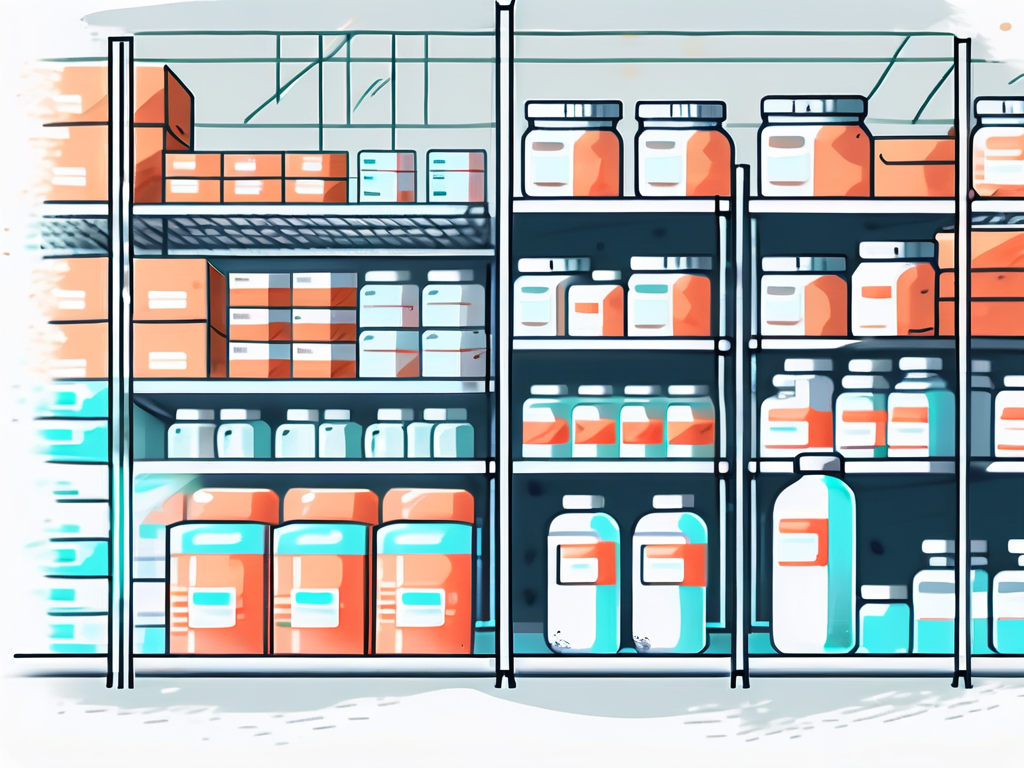In the pharmaceutical industry, effective warehousing is crucial for maintaining product quality, ensuring regulatory compliance, and meeting customer demands. Pharmaceutical warehousing encompasses a wide range of activities, from inventory management to quality control and risk management. To optimize efficiency and minimize risks, it is important for pharmaceutical companies to adopt best practices in their warehousing operations.
Understanding the Importance of Pharmaceutical Warehousing
Warehousing plays a critical role in the pharmaceutical industry. It serves as a hub for storing, handling, and distributing pharmaceutical products. A well-managed warehouse can significantly impact the overall supply chain efficiency and contribute to the success of a company. It ensures that pharmaceutical products are stored properly, remain in optimal condition, and are readily available for shipment.
The Role of Warehousing in the Pharmaceutical Industry
Pharmaceutical warehousing serves various purposes, including:
- Storing and preserving pharmaceutical products: Warehouses provide controlled environments necessary for preserving the potency and integrity of pharmaceutical products, such as temperature-controlled areas for storing vaccines and refrigerated areas for perishable medications.
- Facilitating efficient inventory management: Warehouses enable accurate tracking and management of pharmaceutical inventory, ensuring sufficient stock levels and minimizing the risk of stockouts or overstocking.
- Enabling timely order fulfillment: By organizing products in a logical manner and implementing efficient picking and packing processes, warehouses enable quick and accurate order fulfillment, ensuring timely delivery to customers.
Key Challenges in Pharmaceutical Warehousing
Pharmaceutical warehousing is not without its challenges. Some of the key challenges include:
- Stringent regulatory requirements: The pharmaceutical industry is highly regulated, and warehouses must comply with various regulatory standards, including those related to storage conditions, handling procedures, and documentation.
- Product integrity and quality control: Maintaining product integrity and quality is crucial in the pharmaceutical industry. Ensuring proper storage conditions, minimizing temperature variations, and implementing robust quality control measures are essential in warehouses.
- Inventory management complexities: With a wide range of pharmaceutical products, managing inventory levels, expiration dates, and product rotation becomes complex. Implementing effective inventory management systems and processes is essential to avoid stockouts or wastage.
Furthermore, pharmaceutical warehousing also faces challenges in terms of security and safety. Due to the high value and sensitive nature of pharmaceutical products, warehouses need to have stringent security measures in place. This includes surveillance systems, access control mechanisms, and strict protocols for handling and transporting pharmaceutical products.
Another important aspect of pharmaceutical warehousing is the need for specialized equipment and infrastructure. Temperature-controlled storage areas, cold rooms, and cleanrooms are essential to maintain the quality and efficacy of pharmaceutical products. Additionally, warehouses need to invest in advanced technology and automation systems to optimize storage space, improve picking and packing processes, and enhance overall operational efficiency.
Moreover, the geographical location of pharmaceutical warehouses plays a significant role in the supply chain. Warehouses need to be strategically located to ensure efficient transportation and distribution of pharmaceutical products. Proximity to major transportation hubs, such as airports and seaports, can help reduce transit times and minimize the risk of product spoilage or damage during transportation.
In conclusion, pharmaceutical warehousing is a critical component of the pharmaceutical industry. It serves multiple functions, including storing and preserving pharmaceutical products, facilitating efficient inventory management, and enabling timely order fulfillment. However, it also faces challenges related to regulatory compliance, product integrity, inventory management complexities, security and safety, specialized equipment and infrastructure, and geographical location. Overcoming these challenges is essential to ensure the smooth and efficient operation of pharmaceutical warehouses, ultimately contributing to the success of pharmaceutical companies and the well-being of patients.
Essential Best Practices for Pharmaceutical Warehousing
To overcome the challenges and optimize pharmaceutical warehousing, companies should implement the following best practices:
Implementing Effective Inventory Management
Effective inventory management is crucial for maintaining the right levels of stock while minimizing the risk of expiration or obsolescence. This can be achieved by:
- Implementing inventory control systems: Utilizing inventory management software and barcode scanning technologies can streamline inventory control processes and provide real-time visibility into stock levels.
- Implementing the first-in, first-out (FIFO) principle: Ensuring that products with the closest expiration dates are used or shipped first reduces the risk of product wastage.
- Regularly conducting cycle counts: Regular physical counts of inventory help identify discrepancies between the actual stock and recorded levels, enabling timely corrective actions.
Furthermore, companies can also consider implementing automated replenishment systems that use historical data and demand forecasting algorithms to automatically reorder stock when inventory levels reach a predetermined threshold. This proactive approach can help prevent stockouts and ensure a continuous supply of pharmaceutical products.
Ensuring Quality Control and Compliance
To maintain product integrity and comply with regulatory standards, pharmaceutical warehouses should:
- Establish stringent quality control measures: Regular inspections and quality checks of stored products help identify any deviations from the expected quality standards and ensure product safety.
- Implement temperature monitoring systems: Continuous monitoring of storage conditions, such as temperature and humidity, helps detect any abnormalities that may impact product stability.
- Train staff on regulatory requirements: Proper training and regular updates on regulatory requirements ensure that warehouse personnel are aware of and adhere to the necessary procedures.
In addition to these measures, pharmaceutical warehouses can also invest in advanced tracking technologies, such as RFID (Radio-Frequency Identification) tags, to enhance traceability and ensure the authenticity of pharmaceutical products throughout the supply chain. This level of transparency not only improves compliance but also helps in the event of product recalls or quality investigations.
Leveraging Technology for Warehouse Efficiency
Pharmaceutical warehouses can significantly benefit from integrating technology in their operations. This can include:
- Warehouse management systems (WMS): WMS software automates and optimizes warehouse processes, such as inventory management, order picking, and shipment tracking.
- Automated material handling systems: Utilizing technologies such as conveyors and robotics can improve efficiency and accuracy in handling and moving pharmaceutical products within the warehouse.
- Data analytics and predictive modeling: Leveraging data analytics can provide valuable insights into demand patterns, inventory forecasting, and process optimization in pharmaceutical warehousing.
Moreover, pharmaceutical warehouses can explore the use of emerging technologies such as blockchain to enhance supply chain transparency and security. By leveraging blockchain’s decentralized and immutable nature, warehouses can ensure the integrity of data related to product origin, storage conditions, and distribution, thereby reducing the risk of counterfeit or compromised pharmaceuticals entering the market.
In conclusion, implementing these best practices and leveraging technology can help pharmaceutical warehouses overcome challenges, ensure compliance, and optimize their operations. By prioritizing effective inventory management, quality control, and the adoption of innovative technologies, companies can maintain the highest standards of safety, efficiency, and customer satisfaction in the pharmaceutical supply chain.
Strategic Planning for Pharmaceutical Warehousing
In addition to implementing best practices, strategic planning plays a vital role in optimizing pharmaceutical warehousing operations.
Designing a Warehouse Layout for Optimal Efficiency
The layout of a pharmaceutical warehouse should be designed considering factors such as product characteristics, storage requirements, and operational flow. Key considerations include:
- Zone segregation: Segregating different product categories or storage conditions into zones ensures efficient organization and reduces the risk of cross-contamination.
- Optimizing space utilization: Utilizing vertical space with mezzanines or high-density racking systems helps maximize storage capacity.
- Efficient workflow design: Minimizing unnecessary movement within the warehouse and optimizing the flow of goods from receiving to storage, picking, and dispatch areas improves operational efficiency.
Planning for Future Growth and Expansion
Warehousing requirements are not static, and pharmaceutical companies need to plan for future growth and expansion. Some considerations include:
- Scalability: Implementing scalable technologies and infrastructure allows for easy adaptation to changing business needs and increased storage capacity.
- Strategic partnerships: Collaborating with logistics providers or third-party warehousing services can be an effective way to handle seasonal fluctuations, expand distribution networks, or enter new markets.
- Continuous process improvement: Regularly evaluating warehouse operations, identifying bottlenecks, and implementing process improvements ensure ongoing optimization.
Risk Management in Pharmaceutical Warehousing
Identifying Potential Risks and Threats
Pharmaceutical warehouses face various risks, including theft, temperature excursions, natural disasters, and product contamination. Conducting a comprehensive risk assessment helps identify and prioritize potential risks.
Developing a Comprehensive Risk Management Plan
Having a robust risk management plan in place mitigates the impact of risks and ensures business continuity. This may involve:
- Implementing security measures: Utilizing access control systems, surveillance cameras, and alarm systems deters theft and unauthorized access.
- Establishing a disaster recovery plan: Developing contingency plans for scenarios like power outages, fire outbreaks, or severe weather events helps minimize operational disruptions.
- Regular audits and inspections: Conducting regular audits and inspections helps identify areas of vulnerability and ensures adherence to regulatory requirements and best practices.
The Impact of Regulatory Standards on Pharmaceutical Warehousing
Understanding Regulatory Requirements
Compliance with regulatory requirements is paramount in pharmaceutical warehousing. Key regulatory areas include:
- Good Distribution Practices (GDP): GDP guidelines outline the standards and procedures for storage and transportation of pharmaceutical products to ensure their quality, safety, and efficacy.
- Temperature control requirements: Regulatory bodies specify temperature ranges and monitoring requirements for different types of pharmaceutical products.
- Serialization and traceability: Many countries require pharmaceutical companies to implement serialization and traceability systems to combat counterfeit drugs and ensure product authenticity.
Strategies for Maintaining Compliance
To maintain compliance with regulatory standards, pharmaceutical warehouses should:
- Establish standard operating procedures: Clear SOPs for storage, handling, and transportation of products ensure consistent compliance with regulatory requirements.
- Invest in training and education: Regular training programs help ensure that warehouse personnel are knowledgeable about regulatory requirements and understand their roles in maintaining compliance.
- Engage in continuous improvement: Regularly reviewing and updating processes, systems, and training programs help address emerging regulatory challenges and maintain compliance.
By adopting these best practices and implementing strategic planning, pharmaceutical companies can enhance the efficiency, safety, and compliance of their warehousing operations. Effective pharmaceutical warehousing not only improves supply chain performance but also contributes to the overall success of the industry in securely delivering lifesaving medications to patients.







